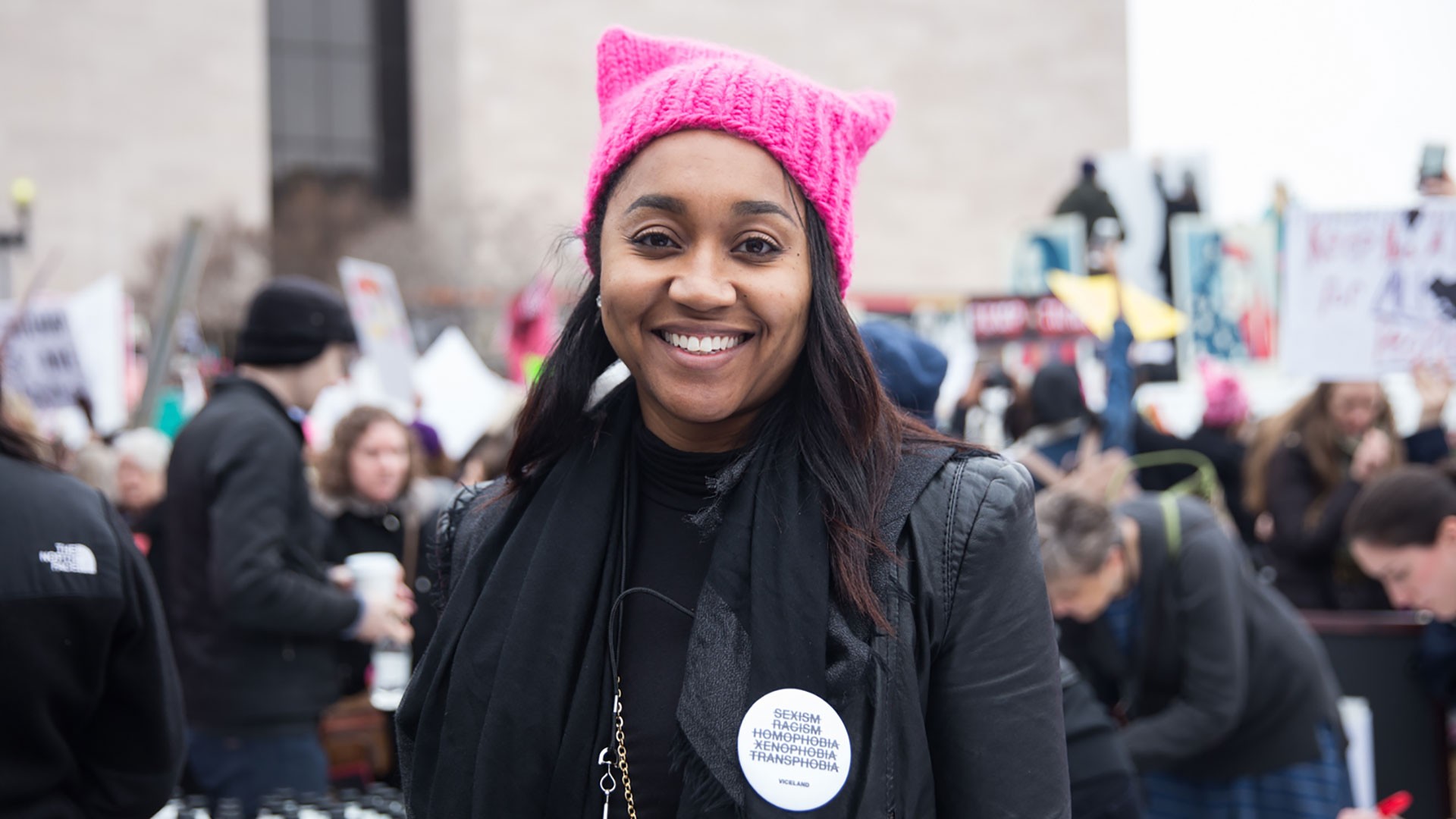It’s been estimated that the Women’s March on Washington on January 21 last year, and more than 600 local marches across the United States, likely brought out at least four million participants – potentially between 3,267,134 and 5,246,670 people. Not to mention sister marches around the world that saw hundreds of thousands of people participating in solidarity in the movement to fight for women’s rights. Now, one year since the historic marches, protestors around the world, led by women, are planning to hit the streets again. And it continues to be important to elevate and create spaces for all women of color in every women’s movement – particularly the Women’s March.But when news of a women’s march first circulated, many women of color, with varying intersecting identities, expressed skepticism on whether a new women’s movement in the wake of Trump’s presidency would truly be inclusive to all women of color. The skepticism derived from a history of white feminism that has not included – and at times worked against the unique perspectives and systemic hurdles of women who are not cis straight white women. From the women’s suffrage movement to white celebrities in recent years like, Meryl Streep, wearing a T-shirt for a photo shoot reading, “I’d rather be a rebel than a slave,” – black women, all women of color, have found that their intersecting identities (race, gender, LGBTQ) have often been neglected by white cis women.Furthermore, Trump’s 2016 election victory revealed some hard truths about racist and misogynistic attitudes in America, and energized people of all backgrounds to participate in the Women’s March. But for women of color who are historically victims of police violence, affected most by the gender wage gap, hyper-sexualized – and for transgender women of color who are disproportionately victims of fatal violence, Trump’s election only further uncovered the very real and unique marginalizations all women of color face daily.Jamilah Lemieux, vice president of Men’s and News Programming for InteractiveOne, powerfully encapsulated skepticism that white feminists would participate in the Women’s March on Washington without fully standing in solidarity to fight the injustices women of color face, in an opinion piece for Colorlines last year.“…Many of the White women who will attend the march are committed activists, sure,” Lemieux wrote in part. “But for those new-to-it white women who just decided that they care about social issues? I’m not invested in sharing space with them at this point in history. Will the Women’s March on Washington be a space filled primarily with participants who believe that Black lives matter?…”The inception of the Women’s March on Washington began with Teresa Shook, a white woman who lives in Hawaii, who put a call to have a pro-women’s march on Facebook. She connected with activist and fashion executive Bob Bland, CEO of her company Manufacture New York (MNY), and who had a similar idea to Shook, Elle reported. The March was initially named the Million Woman March, but after criticism that the name appropriated the Million Woman March in 1997, organized by black women in Philadelphia, it was renamed to the Women’s March on Washington – and three women of color joined Bland as co-chairs.
Check out more videos from VICE:
Tamika D. Mallory, co-president of the Women’s March, and the youngest executive director to serve the civil rights organization National Action Network (NAN), Carmen Perez, treasurer of Women’s March and executive director of The Gathering for Justice, and Linda Sarsour, assistant treasurer of Women’s March and executive director of the Arab American Association of New York, have made it clear about their dedication to focus on intersectional feminism.In an interview with The New York Times, Sarsour explained that intentionally focusing on undocumented immigrant women, and all women of color, takes the conversations to necessary “deep places,” even if you sometimes “upset people.” Mallory once declared, “There cannot be a convening in this nation that seeks to address the issues of women where women of color are not sitting in the front seat leading the conversation,” according to CNN, to name a few examples of their messaging.It’s the idea behind the term intersectionality, coined by law professor Kimberlé Crenshaw in 1989, when she argued that black women’s experiences were intersected by racism and sexism, forming a unique experience that deserved its own focus. And the same can be said for transgender, disabled, Muslim, immigrant, Latina, LGBTQ, and gender non-conforming women of color.“Going in, I knew that I had so many people I was trying to represent,” she said. She added, “…because we know the historic ways feminism has excluded trans women, black women, and women of all different backgrounds.”Willis delivered a speech titled “A Vision of LIberation,” in which she alleges, due to a number of factors, her mic got cut off part way through her speech. (You can read the full version of her speech here.)As far as completely committing to advocacy and inclusion for trans women of color, Willis said it’s important to have trans women involved in the “movement planning.” In one example, Willis told VICE Impact that many people in the crowd last year held signs that had messages that were exclusive of trans women.“My hope is that this year we are more on the same page when it comes to what inclusion looks like,” she said. She also noted that the attendees were overwhelmingly white and cis gender, but she also explained that given the march’s initial lack of diversity, she understood that there were people who “still couldn’t see themselves” in the march.
Advertisement
Trump’s 2016 election victory revealed some hard truths about racist and misogynistic attitudes in America.
Advertisement
Check out more videos from VICE:

Tamika D. Mallory, co-president of the Women’s March, and the youngest executive director to serve the civil rights organization National Action Network (NAN), Carmen Perez, treasurer of Women’s March and executive director of The Gathering for Justice, and Linda Sarsour, assistant treasurer of Women’s March and executive director of the Arab American Association of New York, have made it clear about their dedication to focus on intersectional feminism.
Advertisement
And while some white women openly expressed resentment when women of color enforced this argument in conversations on the Women’s March last year, it’s a concept that needs to always be in the conversation for years to come.Raquel Willis, a transgender activist serving as the national organizer for The Transgender Law Center, was a speaker at the Women’s March on Washington last year. Wills told VICE Impact that while she was grateful for the platform at the march, her experience last year was “complex.”"I knew that I had so many people I was trying to represent, because we know the historic ways feminism has excluded trans women, black women, and women of all different backgrounds.”
Advertisement
And inclusion is not just acknowledging a group’s marginalizations, but it’s also supporting women of color who have led the country in the right direction. As the country is still grappling with Trump’s presidency, many women of color continue to point out that more than 53 percent of white women voted for him. Not to mention the praise black women received for significantly swaying the election to Democrat Doug Jones in the Alabama Senate race – 98 percent of black women voters voted for Jones to be exact.
This year the Women’s March is focusing its activism on voter registration, and electing more women and progressives to office through its “Power to the Polls” event on Jan. 21 in Las Vegas.As for the need to uplift black women, and all women of color, Dr. Ashley Farmer, assistant professor at Boston University and author of, Remaking Black Power: How Black Women Transformed an Era, explained to VICE Impact that the advocacy has a domino effect.“The idea here is that everybody gets a little more free by working with black women,” she said. “Everyone benefits from that.” She added, “In the ideal world we listen to what black women need, and we support women at large.”“My hope is that this year we are more on the same page when it comes to what inclusion looks like."
